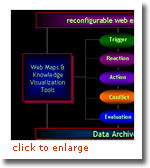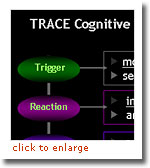

| HOME | ||
| MetaVuMaking Sense of Data |  |
|
| ECOInfosphere |
 |
|
| Collaborative Intelligence |  |
|
| NASAMission-related projects |  |
|
| BEACONBio- Evolutionary Advanced Concepts |
||
| ESACEarth Science & Astrobiology Collaboratory |
 |
|
| ALifeBio-inspired Solutions |
 |
|
| People | ||
| Projects | ||
| Links | ||
| HOME | ||
C-IQ (collaborative intelligence)
builds communication bridges across disciplines to support cross-disciplinary teams working across the domains of design, science, and technology innovation. Its “meta-methods” enable convergence across disciplines.
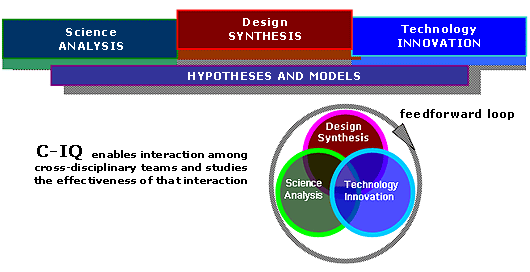
DESYN Lab develops Interactive Frameworks for Decision Support (IFDS).
DESYN Lab integrates outcomes of knowledge-sharing in the content space of each challenge, semantic meta-tagging and threading of user ideas and debates about each challenge, decision support systems to support challenge teams, and collaborative intelligence prompters, recommender systems and other devices for navigating the knowledge space.
The passive wiki mode comprises a knowledge management framework to navigate information and grow resources and archives. The active IFDS mode offers process support for design and collaborative problem-solving. The passive/ active modes are tightly coupled, since each user's path through the knowledge archives (passive) leaves a "pheromone trail" that feeds into the design of the recommender system for future users of the site. User preferences are reflected in automated site updating.
 |
|
||
Just as complexity lies between the two extremes of randomness and order, so between unpredicted information and rigid rules lie knowledge networks comprised of nested layers and their hyperlinks. The dynamic process through which these knowledge networks emerge is driven by local triggers and input, which is collectively filtered and integrated into the evolving network architecture.
As a knowledge network grows, it transforms from low connectivity links into a highly networked coherent, modular, structure. C-IQ “empty constructs” support a five-pronged strategy for the growth of knowledge networks:
- Collaborative autonomy — collaboration without requiring consensus; players have autonomy and ownership of their own pieces under a larger, collaborative umbrella;
- Ecosystem diversity — tolerance, system flexibility to integrate input from a range of data sources and output from a range of participants;
- Adaptive responsiveness — interactive capability of the system to gather input from, and evolve in response to, its users;
- Enabling redundancy — networked, rather than hierarchical, distribution of information; multiple, overlapping categories and methods of search;
- Guidance by assessing fitness — decision-making heuristics, rather than goals, as drivers.
The TRACE cognitive model not only prompts individual users, but also provides a framework within which collaborators can interact. The user interacts with the system in a question prompt and response mode via the user interface, which is coupled to the TRACE Knowledge Processor (patent issued). Collaborators co-evolve solutions in co-located or distributed teams through using a series of steps and question prompts, an “empty construct” framework with a shared graphical user interface. The cognitive process architecture is comprised of five stages, with prompts at each stage.
The five stage TRACE model provides a system framework for discovering, developing, exchanging, applying, and integrating knowledge in individual or group problem-solving tasks, supplying a general template with prompts to aid the user in complex creative tasks, when persons with diverse skills, knowledge and agendas must collaborate. The process model enables users to generate and organize ideas, and to present their results in a format that is easily searchable and accessible as a resource for future users of the system. These five stages can repeat in any order as needed during a development sequence:
Stage One. Triggers elicit question frameworks used to analyze problems, inventory needs, conduct background research, find motivations and generate new ideas.
Stage Two. Reaction biases respond to triggers, initiating gather background information, and initiate probes toward actions. Analysis and question-framing precede decision-making. Brainstorming channels interpretation, reacting to triggers, using criteria for decision-making to focus the process.
Stage Three. Actions require assessing interim interpretations as methods evolve, tools are organized and an implementation plan is prepared.
Stage Four. Conflicts are various forms of negative feedback that collides, guides and redirects the process toward a convergent outcome. Interim focus groups/ brainstorming teams seek devils’ advocates, assess hazards, risks, and competitive alternatives.
Stage Five. Evaluation of outcomes, considering future implications and impacts.
| Diagram of desyn.com Credits: Websites as graphs |
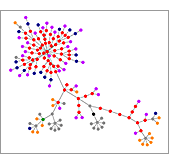 |
Tracing user paths (passive), and linking user contributions (active), evolves knowledge clusters and user communities. Site users can observe the creative process of their collective community participating in the design of new competitions and see how knowledge clusters form, link to other clusters, or dissipate.
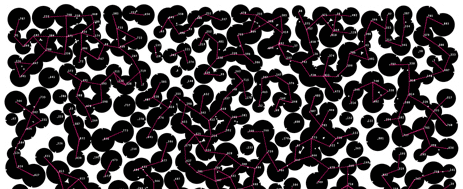 Nodes and Networks: Process 4 (Form 1) - CEB Reas Nodes and Networks: Process 4 (Form 1) - CEB Reas |
Collaborative Intelligence braids multiple points of view together so that diverse, cross-disciplinary teams converge toward a shared design or problem resolution that no one could conceive alone.
Evolutionary EmergenceDESYN Lab uses principles of evolutionary emergence — bottom up structuring, rather than traditional top-down hierarchical control, enabling
- collaboration to develop new rules of play and performance benchmarks;
- innovation and problem-solving process tracking;
- building and assessing automated systems to support collaborative intelligence and innovation;
- designing systems to adapt and evolve to perform with increasing efficiency;
- developing and testing usefulness of each system as a prototype for other application domains.
- knowledge sharing and self-organization across projects, disciplines, and through time;
- how process data can be gathered, archived and used for process improvement by humans and/or intelligent agents;
- how to support cross-disciplinary innovation, collaborative scenario-building, and
- rapid response where collective action by diverse human/ agent teams is needed to address complex problems.
Data mining can harvest patterns in navigational, user-focused, content-structured data. Data and knowledge modeling, integration and management for personalization, e.g. personalized taxonomies/ ontologies for particular individuals and user communities; semantic web-mining using the syntactic layer (XML), the vocabulary layer (RDF-Schema) or the logic layer (Description Logics/ OIL). Challenges in developing architectures include the need for semantically-enhanced collaborative filtering techniques, adaptive systems, and hybrid recommender systems.
Embedded Continual Assessment:
IFDS systems for C-IQ / Collaborative Design
DESYN Lab is a proving ground to develop IFDS systems and to translate what we learn to support collaborative intelligence in federated, distributed teams.
![C-IQ [Collaborative Intelligence]](images/ppt_01.jpg)
